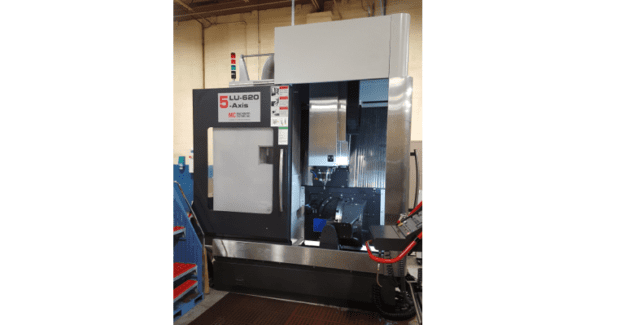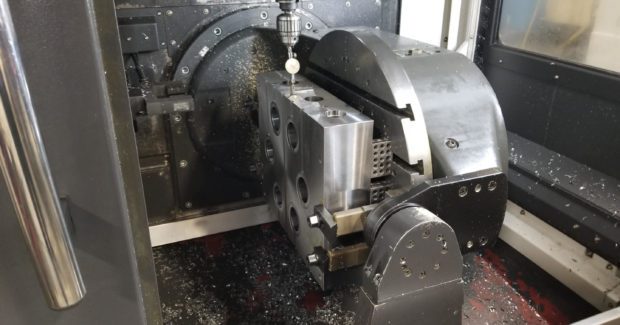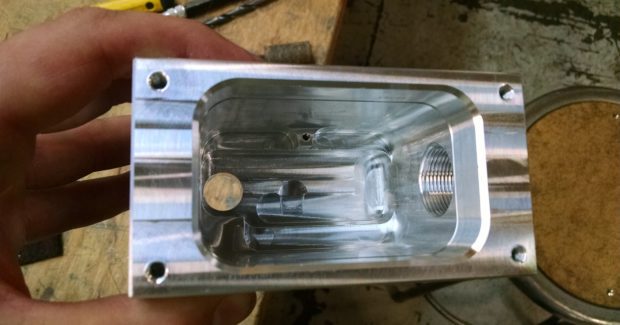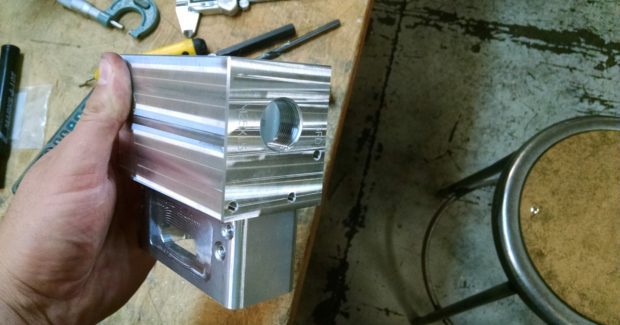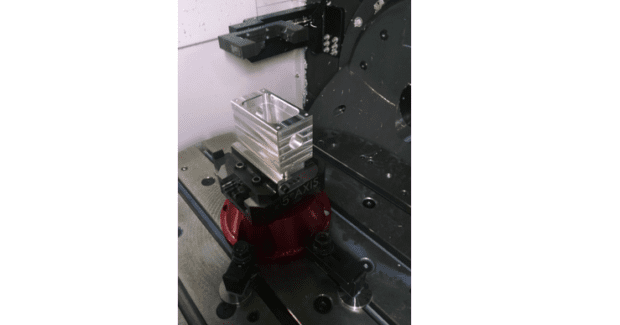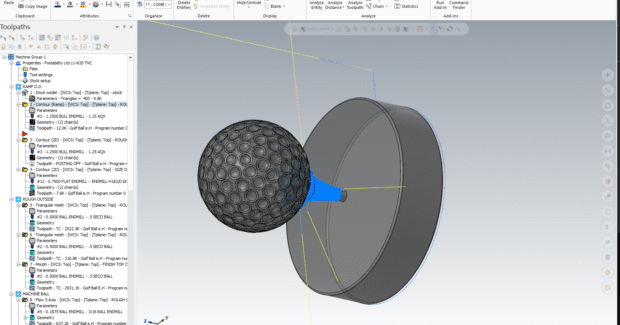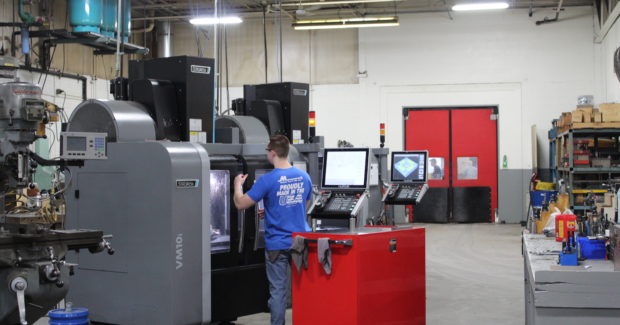Growing CNC Services With 5-Axis Milling
McAfee Tool & Die is successful because it’s always ready to take a leap of faith with new technology. When owner Gary McAfee bought a 5-axis machine, he realized it was time to update the shop’s CAD/CAM software.
Posted: July 27, 2020
CAD/CAM INSIDER COLUMN
BY BEN MUND
Keeping pace with manufacturing means keeping pace with technology. A contract shop doesn’t just efficiently produce accurate parts; it also customizes solutions that cater to customers’ broadening needs. Five-axis CNC machining supports this dual mission by providing versatility, time-savings, and precision.
The benefits of 5-axis machining come from a reduction in workpiece repositioning and secondary operations. One-setup machining eliminates the need to design and build extra fixturing. Every time an operator moves a workpiece from one fixture to another, there’s a risk of misalignment; 5 axes virtually eradicate stacked errors. It improves machining accuracy and reduces machine downtime. More-aggressive cuts can be taken without increasing risk of collisions or gouges.
The result is the ability to make parts that were too difficult or impossible before because they required too many setups on a 3- or 4-axis machine to be profitable or had geometries that couldn’t be achieved on a 3- or 4-axis machine.
Versatile Software For A Versatile Shop
McAfee Tool & Die Inc. (MTD) owner Gary McAfee has relied on CNC machining since launching the Uniontown, Ohio, company in 1977. The company provides tool and die stampings, reverse engineering, concept design, prototyping, and permanent tooling services for the automotive and aerospace industries. Certified to ISO 9001:2015 and for aerospace with AS 9100:2016 (Rev. D), over four decades its customer base has expanded to other states and countries.
“In many cases, they come to us when they have nowhere else to turn,” says Senior Programmer John Stiles. “We’ve had customers come to us with non-standard gears from old machines or equipment. They don’t have any prints or data, and we have to ensure correct fits.”
MTD owns two Hurco 3-axis milling machines; Hitachi, Mitsubishi, and OKK 4-axis vertical machining centers; five Mitsubishi wire EDM machines; a Mazak laser machine; and a Mazak lathe with live tooling. When Gary McAfee bought a 5-axis MC Machinery Systems Model LU-620 (specs: Heidenhain control; 12,000-RPM spindle) in 2017, he realized his team needed software versatile enough to design and program any job on any CNC machine.
“We wanted a program that’s functional for everything we do, and we do a lot of different things,” he says. He and Plant Manager Joseph Lysiak traveled to the International Manufacturing Technology Show (IMTS) in Chicago in hopes of finding a solution.
They heard about Mastercam CAD/CAM software from other attendees and decided to give it a try.
Pricing Considerations
Back home, they tasked Stiles with testing the software. He reached out to FASTech Inc., a certified reseller in Findlay, Ohio, to ask Sales Manager Kevin Richardson about specific features. Richardson immediately brought Technical Expert Scott Harding to the shop, where they programmed a part for an order, explaining each step to Stiles and programmer Ben Ohler.
“We got a time-pressing job completed and a demonstration on level of support,” says Ohler.
Harding also explained the training and troubleshooting help MTD could expect. McAfee knew transitioning to new software would be expensive. However, Mastercam developer CNC Software Inc. includes translators, post processors, and support in the software’s annual license fee instead of charging additional fees.
“Once in a while we’ll run into something that makes us call support,” says Stiles. “They get right on, and we share screens so they can walk us through it. It’s most valuable to have them when we need to learn something new, though.”
Resolving Part Complexities
Over about four days of on-site training, Harding walked MTD programmers through the intricacies of 5-axis milling. While the course prepared him for all the basics, Ohler felt secure in knowing he could call Harding if he ever had a more complex project – which an electrical box for an oil rig turned out to be.
The box had six sides of machining on two mating parts with a tight tolerance fit between the two. Because of how it’s used, the top needed an incredibly tight fit to keep errant flames out. Machining multiple tight corners inside deep cavities to ensure the fit was a major challenge.
“If you machine away 75% of a block, your sizes change,” says Stiles. “We had to rough-machine all around five sides, then come back and finish all the tight-tolerance areas last.”
Harding showed Ohler software functions, such as Dynamic Motion, that make achieving tight tolerances possible by maintaining a consistent chip load. He was shocked by how much time and stress Harding’s help saved him.
“A chamfer needed to seal with a gasket that went in a groove around the part,” he says. “Between the gasket and the fit, we made it absolutely flameproof.”
Mastercam’s many fail-safes were invaluable to the job.
“Being able to verify the program in the software before it ran on the machine made life less stressful,” says Stiles. “You can see problems before the program gets loaded and runs.”
The Verify and Backplot simulation features help users avoid programming errors and potential damage to parts. The simulation can include anything from just the tool to the entire machine environment, and it’s powerful enough to make an expensive standalone simulator unnecessary.
Machining With Confidence
Even though 5-axis machining is faster than 3- and 4-axis machining, Lysiak is unconcerned about damaging his stock material.
“We have parts with tolerances of less than 0.0005-inch, but we don’t have to worry,” he says. “We can have anyone put it in, push a button, and go. He won’t have to take it off and put it back in again and again, either. Time is money,” he said. With the company’s expanded capabilities, Lysiak’s only concern now is keeping up with increased orders.
While updating equipment and software on a regular basis creates some challenges, the team agrees it creates many more opportunities for expanding business.
“The programming improvement helps us stay ahead of the curve and meet customer demand,” says Lysiak. “When I talk about bringing in more work, the guys in programming just say, ‘Bring it on.’”



